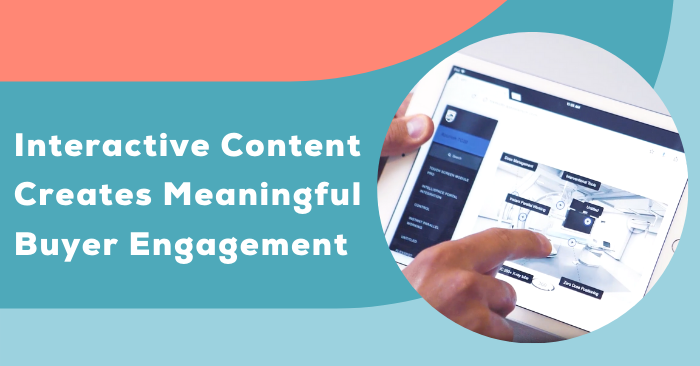
As 2020 quickly creeps up on us, I know many B2B marketers and sellers are in planning mode for new initiatives. If what I’m hearing is true, especially from our customers who attended Modus Summit 19, and heard our CTO and Co-Founder, Scott Olson, talk about various content capabilities within Modus, next year is all about the interactive content. It can be easy to create and deploy, and I’ve seen some pretty cool interactive sales tools being used in our apps. So, as you strategize for 2020 and all the interactive content your sales teams will need... we want to make sure you know all your options for getting even more from Modus in the New Year.
In marketing, we know that interactive content is often more self-serve content where your target market interacts with the content on their own. In sales, we see interactive content being used to deepen conversations and intent toward buying by reinforcing the value shown and fast-tracking clarity. Once the buyer sees the product, they begin to personalize the product’s use to their specific situation.
Recent research from the 2019 Content Preferences Survey has found that 86% of buyers prefer more interactive content they can access on demand. 58% of them are willing to spend five to twenty minutes reviewing interactive content on their own. This familiarity they get on their own is so powerful if executed well. (Of course, with Modus Analytics, you can also know exactly how much time your buyer spends... If you have questions let us know).
It’s no wonder interactive content is all rage... since it drives engagement by tailoring the experience to the buyer’s unique situation, and brings your products to life, helping buyers visualize the value they will get from them. Whether embedded on your website for self-serve use, or initiated during a sales conversation, interactive content and sales tools help fast-track momentum toward the sale.
Virtual Product Tours Deepen Sales Conversations
Within Modus, you can create virtual product tours without fancy file types or design software right in your Hub. It’s easy to combine assets you already have, such as photos, videos, PDFs, brochures to create a 360 spin or 3D model that calls out features of your choosing as they are interacted with. This helps buyers visualize the way specific features will answer the challenges they’re facing today.
If a buyer is on the fence about a certain machine because he can’t actually get in or picture what his view would be like from the cab, showing him that vantage point can help him get invested. Likewise, if you’re selling medical devices, a physician’s attention is divided between you, her patients, and a lot of other noise. Content that helps her quickly visualize the difference your products will make help those short meetings have a bigger impact—and drive momentum toward purchasing.
Web Bundles Help You Deliver Progressive Sales Tools
Effective mobile sales enablement tools are not just about having the product specs and brochure at hand instantly. These tools are also about clearly demonstrating the impact the product could bring to help customers be successful in reaching their goals. Often called Web Bundles, there are a variety of tools out there (we even build them, let us know if you have an idea), most of which will work in your Modus Hub, to help you configure details about potential purchases and share them with buyers.
The ability for your sales reps to work collaboratively with customers using interactive content like a calculator or comparison tools, and then send them a link and a PDF with the final results will boost engagement with that content, as well as further consideration of your products, moving deals forward. Giving reps access to these tools will also increase content engagement, and feedback, as well as provide additional data about buyer behavior.
Think of Web Bundles as mini apps deployed within Modus, that can solve your specific challenges, and bring interactive components to support more productive sales conversations.
Below are Three Interactive Tools for Sales Enablement
1) In-Person Assessments Help Drive Customer Intent
Your sales reps are meeting face-to-face with customers on the job site, in the hospital or clinic, on a factory floor, or in other remote locations. Your portfolio contains an array of products, parts, and solutions that may be a fit, based on both current needs and forward-looking plans. An assessment tool that allows the rep to identify the product that will best meet the customer’s needs and requirements in that moment will help the rep win both trust and the business. Reps without these tools who must return to the office to find the information, then drive back to the site later to answer their customers’ questions will lose momentum with the sale.
Not only does this increase the cost of sales, but it can frustrate the customer and cause their certainty in buying the product to waiver. Even worse, a competitor’s rep could show up with the information needed in hand and win the deal while your rep is searching for answers.
2) ROI and TCO Calculators Build the Business Case
Buyers need to justify their purchase of your products. A sales rep who uses a tool interactively with the buyer to justify the investment using a Return on Investment (ROI) calculator also produces data that leads to strategic conversations that help build the business case and the buyer’s confidence that it’s a good business decision. When sellers demonstrate a direct correlation between your product and achieving their customer’s organizational goals, more sales get done.
Total Cost of Ownership (TCO) calculators are useful in overcoming objections or competitor alternatives by showing the value against the cost of your solution or product over time. They are also a great tool for helping your buyers have conversations with finance leaders. A TCO calculator helps sellers deepen conversations with buyers who are only looking at the purchase price, versus the other costs—all offset by the lifetime value of your products.
Calculators provide your sellers the ability to capture imperative customer data in both your sales enablement solution and CRM for seamless follow up and to help inform future content and presentations. Sellers can also send a PDF of the calculations to the buyer for further consideration and to have internal conversations to move the deal forward.
3) Product and Competitor Comparisons
One of the biggest frustrations’ buyers say they have is an inability to easily compare products to determine their best choice. Arming your sales reps with interactive tools that allow them to compare products—either within your catalog or against competing products—helps buyers to reconcile their thinking and gain clarity about why your products are their best choice.
It’s likely you’ve created competitive battle cards to educate your reps about your competitor’s products. Why not use that information to create a comparison tool that puts that information to work in helping your sales reps have more meaningful conversations with buyers?
Microlearning Elevates Sales Rep’ Expertise
I’ve already talked to you about using Microlearning to improve sales readiness through skills and product training. But you shouldn’t overlook the opportunity to use just-in-time learning to educate sales reps about the content your buyers engage with so they can have better conversations with them based on the information they’ve viewed.
There are many benefits to having sales reps that can speak to the thought-leading ideas and claims made by your content. A brief learning module that shows a rep the key points and takeaways from the content and adds a further idea or insight they can share to build on that content helps them add that elusive value to conversations that your buyers are demanding. Sales reps skilled in talking about the ideas that propel your organization within the industry gain trust, and so does the consistency of having content and conversations that align to what your buyers care about.
Add Interactive Content to Your 2020 Plans
This is not going away and buyer’ expectations are not going to lessen. If anything, their desire for personalized experiences will only continue to grow. Interactive
content can be used in a variety of ways to help engage buyers on their own or to help sales reps have deeper conversations that drive momentum toward buying.
Modus can become (or continue to be) the Sales Hub that helps you help your reps align more quickly with buyers and build the trust needed to get more sales done.
If you’d like to see how interactive content can help you reach your objectives in 2020, let’s talk about what’s possible in your selling environment.



